Neil Peart's News, Weather and Sports
It's Not Over When It's Over
NeilPeart.net, August 23, 2013
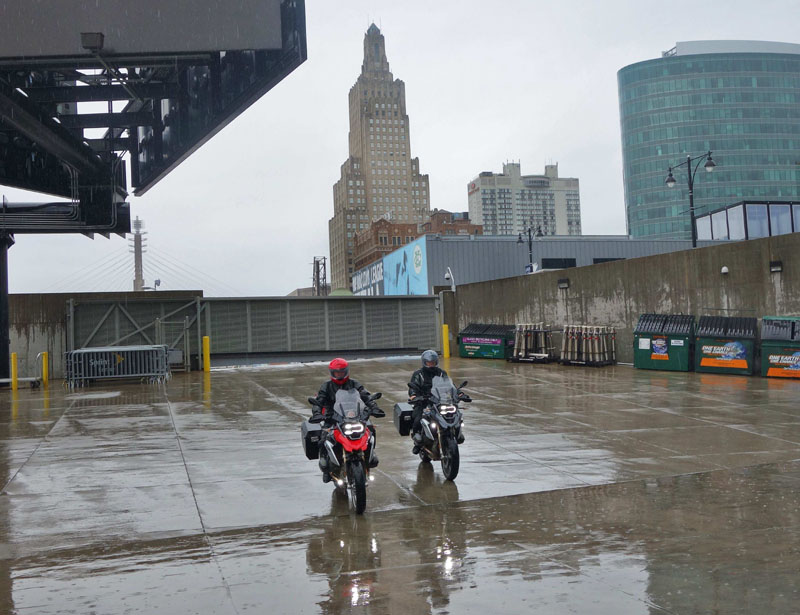 |
Last Day at Work, Kansas City |
Once again I find myself beginning a story at the end. Maybe it's my new style. Maybe it's just my age-laying things out according to freshness rather than chronology.
Here Michael and I are riding into the rainy load-in area behind the arena in Kansas City, before the final show of the Clockwork Angels tour, on August 4, 2013. (Photo by Mac McLear, our lead truck driver since...1977!) Later that day, when I added up my mileages for the tour, I learned that with Michael, Brutus, and occasional guest riders, I had ridden my motorcycle over 28,000 miles between those seventy-two shows.
As always, completing the final ride was a stirring moment. I swung my leg over the saddle for the last time with a palpable sense of...complicated emotions. Something like a sandwich of whole-grain pride and satisfaction, around a thick wedge of weariness, and a side of relief. A phrase I came up with years ago rings ever more true, "When I am riding my motorcycle, I am glad to be alive. When I stop riding my motorcycle, I am glad to be alive."
That afternoon I asked bus driver Dave about his mileage for the tour, taking direct routes between the shows. Even discounting the 3,000 miles Brutus and I rode in Europe, with a different bus, my two-wheeled traveler had covered 5,000 miles more than the buses and trucks.
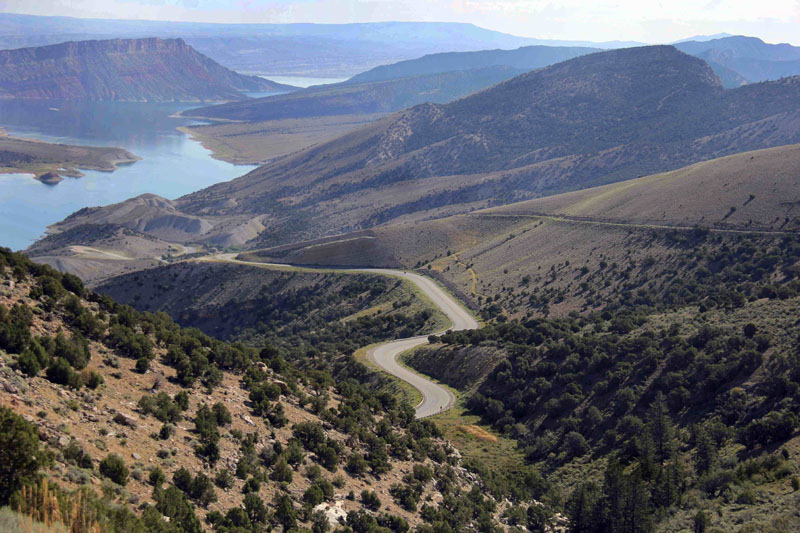 |
Flaming Gorge, Wyoming |
And oh, the places I had gone...
(My motorcycle and I are a tiny dot in the middle of this "far and away" photograph, a majestic panorama hazed by a forest fire Michael and I had ridden through-literally- a few days before.)
Lately the phrase "It's not over when it's over" has become another one of those endlessly resonant and applicable mantras-like "On Days Like These" in the previous story. The twist, and possible addendum, to Yogi Berra's famous quote, "It ain't over 'til it's over" applies to many of the situations in my touring life-and perhaps beyond. Like the end of a show, the end of a day's motorcycle ride, or the end of a long, hard tour.
In the early summer of 2013, as we approached the end of the tour, friends outside the touring vortex were saying things like, "It's almost over now," "Only six more to go," or, "I bet you can't wait for that last show."
Well, yes-but in reality, it's not like you play the last note of the last show, and suddenly feel perfectly wonderful. Oh no. And even one show is a serious barrier between "being" and "nothingness" (in a good way!). Sustaining that performance edge, giving everything you have every night (or every second night), is a "constant loss" system. You can't possibly replenish the expended energy, so the reserves just gradually deplete.
Same after each show-I don't suddenly feel good just because it's over. There are wet clothes to peel out of and hang up (hat on one closet handle, shirt on another, pants on another, socks draped over my riding boots), all on a moving bus that's often jostling out of a parking lot onto bumpy city streets, with sudden stops and turns. Bad words are sometimes spoken.
Towel off the sweat, dig out a dry T-shirt and gather the towels to bring to the front lounge to sit on (bus-surfing all the way against swaying and bouncing), and to continue drying the still-oozing sweat on my forehead. Then sit and put my feet up on the opposite bench for that precious first drink and smoke, as the previously-ignored pain starts to "blossom" all over my body.
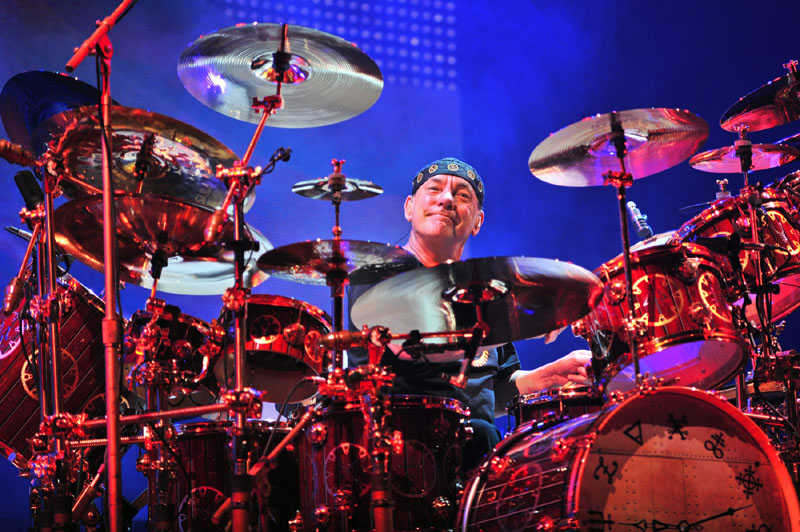 |
"Hi Craiggie!" |
When the tour is over, for real, I will be so drained and strained that it will be many weeks before mind and body start to return to some kind of "equilibrium"-when the pain subsides, and the mental tension begins to ease. My drumming is an athletic activity, no question, which requires months of preparation. The process of relaxing means letting that go-getting out of shape. That can be nearly as painful as getting into shape. Day after day, each muscle group takes its turn to release its tension and fatigue, and I will feel it all unwind.
But what a truly triumphant tour it was!
The emotional resonance of the final show, in Kansas City, inside us and around us, could only compare to the first show of our Vapor Trails tour, in Hartford, Connecticut, on June 28, 2002. That "new beginning" came after five intensely difficult years since our last performance on July 4, 1997. When that Hartford show was over, I said to our manager, Ray, "It would have been a shame if that had never happened again." He smiled and nodded, and we raised our glasses of champagne.
Eleven years later, that August night in Kansas City was the ultimate tour-ending show in all our thirty-nine years of "roadwork." It affected us in ways we could never have expected, and most of that emotion was centered on the Clockwork Angels String Ensemble. Usually the Guys at Work, band and crew, finish a tour believing it's just a break-that it will all start up again at some point, and we'll all see each other again. All seven of the "stringers" knew that this time it truly was, like the lovely title of a Hemingway story, "The End of Something."
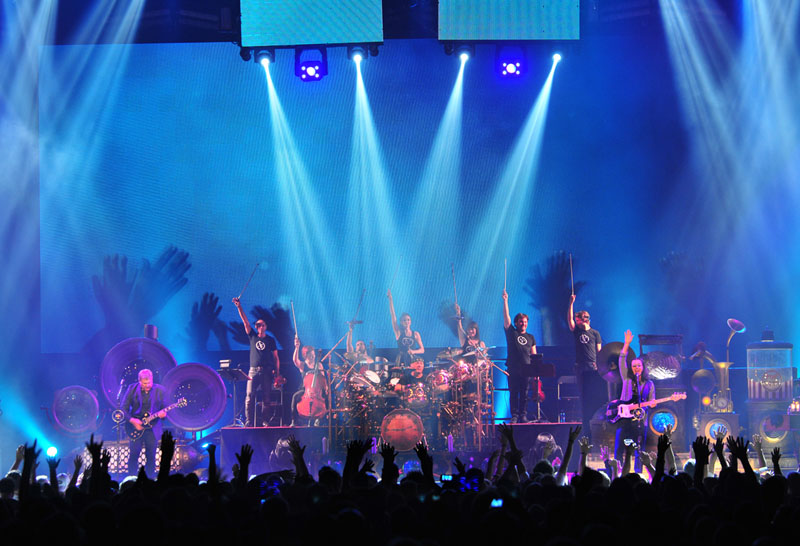 |
The Clockwork Angels String Ensemble, "As if to fly" |
Mario, Adele, Jacob, Audrey, Gerry, Jonny, and Entcho had traveled together, played together, and lived together for the better part of a year. In their own words, they had become "a family"-sharing buses, dressing rooms, and stages for all of those shows, and the days off between them.
So the final show, in Kansas City, was both triumphant and bittersweet.
The ten musicians on that stage knew that, no matter what, there would never be another performance like that. We gave it everything, and the audience gave it right back. There were tears, all right (I warned Adele, "Don't you start crying, or I will, too. I cry very easily!"), but they were happy tears.
At the start of "The Garden," certainly the most emotional song in our set this tour, tiny sparks appeared in the darkness, people holding up hundreds of small electric lights, like fireflies. That added to the magic of the moment, and somehow to its depth of feeling. In Olden Times (the '70s), audiences used to do that with lighters during particularly "intimate" parts of a rock concert, and here was an attractive and touching revival.
Coincidentally, the beginning of "Closer to the Heart" used to be a moment like that in our shows, back in the day, and that song brings another wonderful connection. Just before that Kansas City show, the stringers visited our dressing room and presented the three of us with a CD they had recorded on their own-"Closer to Our Hearts," an intricate string arrangement of our song by cellist Jacob. The disc was packaged with style and detail, accompanied by a signed copy of the score, and of course, an eight-by-ten glossy. They had also collaborated on a framed "award" for each of us, to commemorate the selling of "three copies"-a humorous echo of the Canadian gold records for Clockwork Angels we had given to the stringers at an earlier show. Jonny gave a little speech that was heartfelt and funny, and when some of them told us this tour had been the greatest musical experience of their lives, the three of us could only agree. For all of us, after long careers, that was saying something.
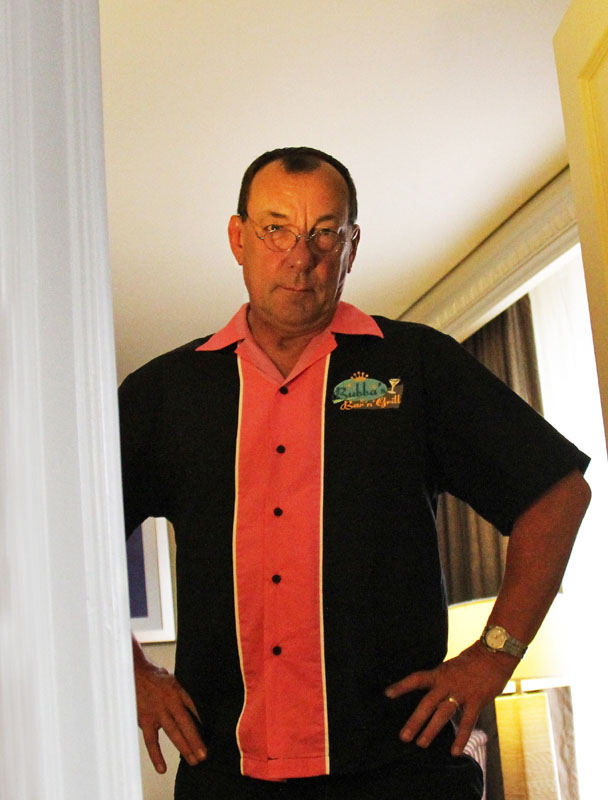
At the previous night's end-of-tour bowling party, a tradition going back many tours (and much more fun than golf, some of us think), we all had a joyous, even riotous good time. I am not skilled at bowling-or any sports-but at least I looked the part, in my Bubba's Bar 'n' Grill bowling shirt. (I received many inquiries about it from crew members, as did truck driver Steve in his matching number. I told them we were sold out of the "normal" sizes, but suggested they all be sure to mention it to merch guy Patrick. Later Patrick stopped by my lane and gave me a wry face. I responded with surprised innocence, as he told me we would soon be restocked.)
Actor Paul Rudd spent much of his youth around Kansas City, and was visiting at the time of our show-so he joined us for the bowling party. We had kept in touch since our scene together in I Love You, Man (2009), and Paul's appearance with Jason Segel in the show-ending movie for our Time Machine tour. The bowling alley kicked us out at nine o'clock, because it was time for the all-important, perhaps even sacred "Leagues" to have their turn, and Paul took us to a private room in a friend's bar-with Kansas City truly rocking in the streets all around us. What a party town on an uptown Saturday night!
I think it was as late as midnight when Michael and I were heading back to our hotel. (I smiled to pass a huge mural of native son Count Basie, who launched his fiery, stomping big-band sound in Kansas City.) That witching hour was fairly shocking for us West Side Beemer Boyz, who were usually asleep by about nine-thirty on nights off-especially lately, with all the long rides in the Intermountain West. With the absurd distances to travel every day, I had been dragging my riding partners (a couple guest riders for those "Big Sky" rides) out of their beds at six a.m.-to get in a hundred miles or so before breakfast.
(A worthy title: "A Hundred Miles Before Breakfast.")
The bowling party was a crowning event for the sixty-five of us who had worked together on that tour. The camaraderie among band and crew had never been greater, and morale had never been higher. Such happy spirits were not shared among certain other groups of people we encountered on that same night...
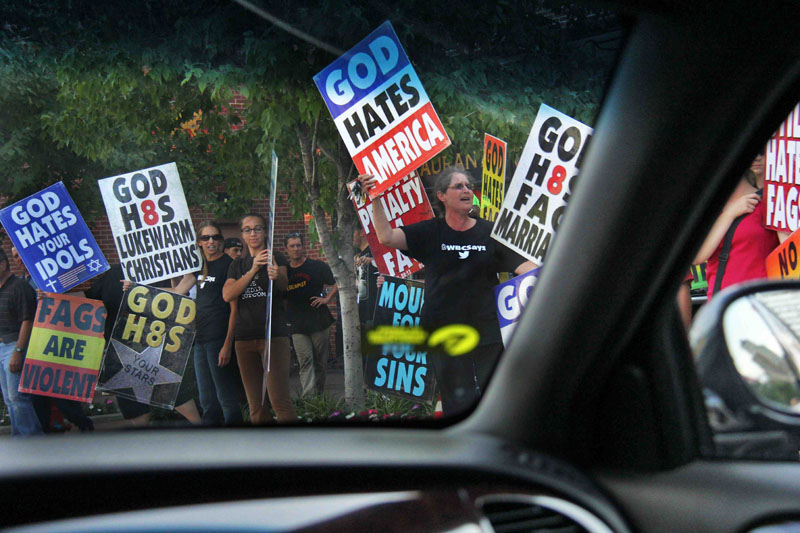
It happened that the bowling alley was across the street from the arena where we would play the following night, which that night hosted Taylor Swift. Here is what we encountered driving up to the bowling alley, on a street thronged with Taylor Swift lookalikes ("Swifties") and many of their less-excited-looking parents. In the middle of all that, a demonstration was being staged (apt word) by the "Christian" group called Westboro Baptist Church. Two prominent signs were "God Hates Fags" and "God Hates Sluts." Not sure under what category they hated Ms. Swift. Comment seems superfluous, but it struck me how their free speech, however hateful and demented, was protected by a cordon of police, on foot and motorcycles.
Oh yes, right-motorcycles!
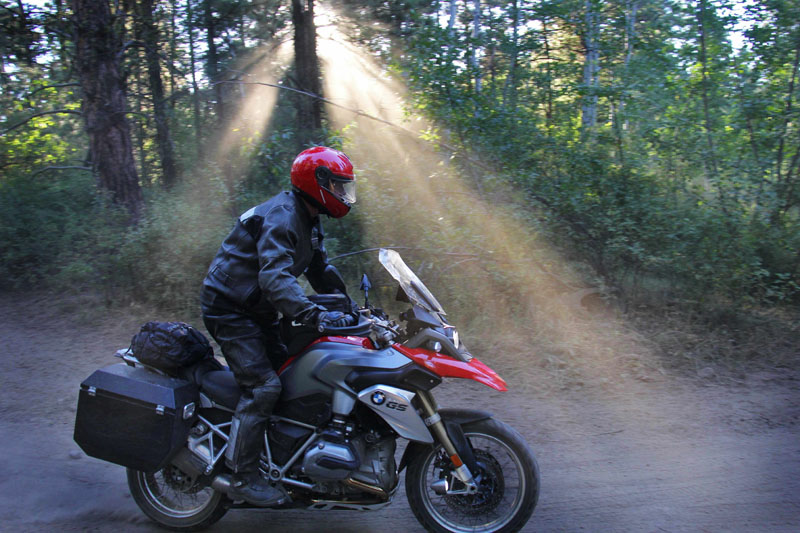 |
Bubba in Hallowed Light |
Look at me going on all this time, and I haven't even mentioned the motorcycling!
My travels with Michael, and occasional guest riders, between those shows had their own elements of triumph and physical and emotional strain. The above image appears to be a glorious moment-a pre-Raphaelite painting in the forest dawn, as a leather-armored knight manfully negotiates a wilderness path, bathed in "ecclesiastical" light. And it happened to be Sunday morning, too.
However, the cause of that "halo effect," which might be the envy of the band's lighting director, Howard, was not the dust of our passage, but smoke from a major forest fire. We were about to ride straight into it, with no idea.
At six o'clock that morning we pulled out of the motel in Wenatchee, Washington, knowing we had a long way to travel to the show near Portland. Also, an early part of the day's route was one of our "mystery roads"-a long unpaved stretch I had highlighted on the paper map. Michael's mapping program, "Mother," had balked at it, but produced some kind of route for us to follow. However, we knew from much experience that Mother's interpretation might lead us into abandoned logging roads that were no longer passable, or barely so (see "On Days Like These"), or even steel barricades or fallen bridges that would send us back the way we had come.
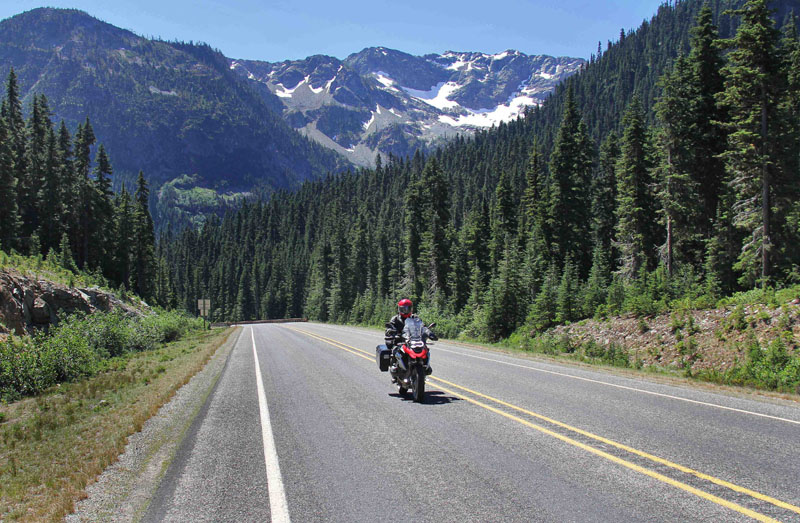 |
North Cascades National Park |
At least the previous day's mystery road had been a success. Leaving the bus at the Château Walmart in Burlington, Washington, we rode east through North Cascades National Park to the drier side of those mountains. (The word "rainshadow" sounds gloomy, but it means the side that doesn't get rain-where it's bright and sunny!)
The weather was superb, the scenery majestic, and the roads winding and entertaining. In early afternoon, we rounded the shore of Lake Chelan, and I saw the GPS route was leading us away on a paved highway. I knew that wasn't right, and kept going-my memory of the paper map overruling Mother, both GPS units, Doofus and Dingus, and even Michael. (He is often fooled by Mother that way, when he clicks on two points on my route and expects her to draw the desired line between them. She very well may not. After every episode like that, I wag my finger and scold Michael like a third-grade teacher, "Check your work!") When he didn't appear behind me for a while, I rode back and found him stopped at the side of the road, waiting for me to ride back to him-like he was sulking.
All urgent and confident, he said, "This isn't the right way-I remember from Mother. We were supposed to turn left back at that highway. We have to turn around."
At first I could only look at him. Then I said, "Why do you always get like this near the end of a tour?"
"Like what?"
"All argumentative, all stroppy, all negative, all...insubordinate. All your 'cognitive dissonance.'"
(One prime example of that psychological mechanism that Michael and I always refer to is when someone is about to be separated from a loved one, and picks a fight-so they can go away mad instead of sad.)
I impugned his masculinity, and said, "We have lots of time, and lots of gas-just man up for a few minutes and let's check it out."
That prompted Michael to laugh and add one (actually two) more items to the list: "We have time." "We have gas." "And we have...
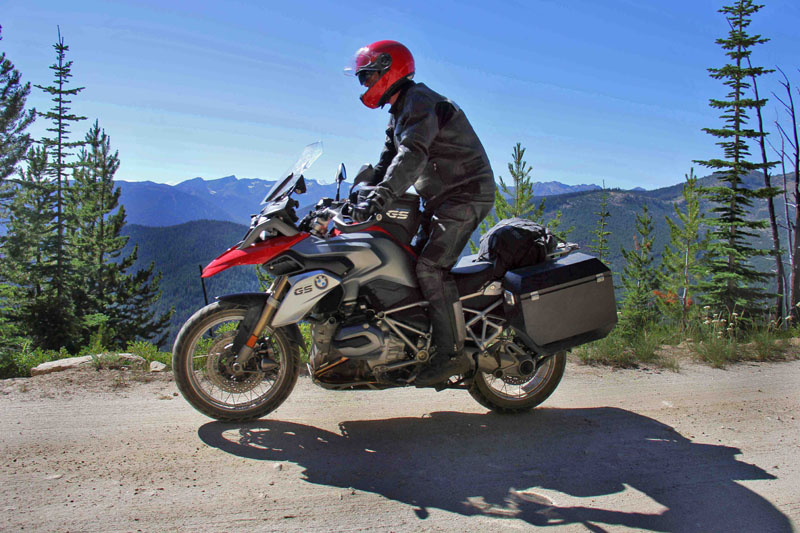 |
Climbing Shady Pass, Washington |
Let's say "fortitude." (Michael is so often unprintable, while I strive to keep my contribution to our discourse to the highest standards of decency.)
Where the pavement ended, Michael stopped to talk to a local on an ATV, and the man told him it would take us four hours to get through that way, and that we should backtrack to the highway.
I don't know, I must have been feeling "determined" or something, but it didn't seem that way to me. Right at that point, where the road turned to gravel, a sign read "Primitive Road-No Warning Signs" (which was warning enough, in its way). More useful was a final sign listing distances and destinations. I recognized Eniat Valley from a town of that name on our route, and thought that was a good omen. It was 26 miles away-but 26 miles of what?
I switched to the compass screen for navigation, and noticed that sometimes we were heading northwest instead of roughly southeast. I too became doubtful, but then the track would swing around again through the pines-vast stretches of them bare gray columns from a forest fire, just greening again in the ground cover.
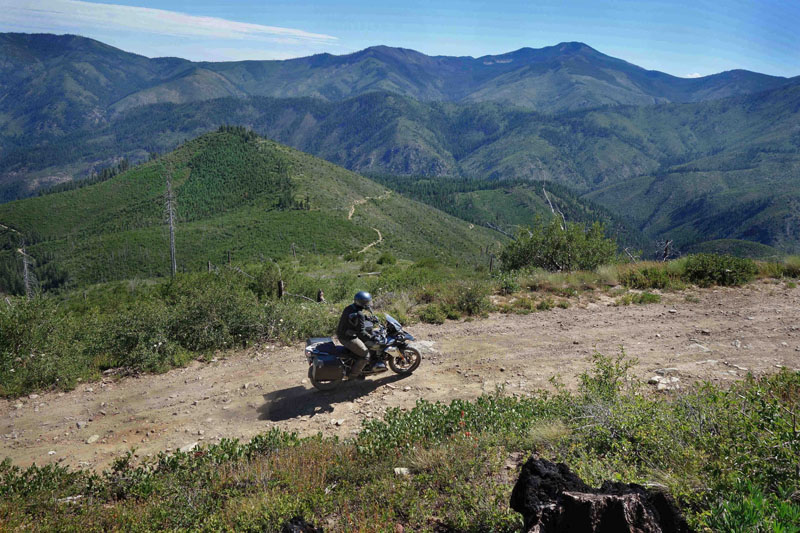 |
Shadeless Shady Pass |
I also kept an eye on the elevation, and saw us climb to about 7,500 feet-the delicious thinness of mountain air and the evergreen fragrance a sensory delight. Here was a fitting answer to Michael's doubt, an antidote to any negativity. Worth turning around after, if necessary.
But despite Michael's trepidation, and the unhelpful Mother (Doofus and Dingus did okay, under the circumstances), Shady Pass proved to be everything it ought to have been-remote and challenging, yet delivering us to our destination.
The next morning was an entirely different definition of "everything it ought to have been." Heading for Portland at six a.m. (always seems like a "nice round number" for this rider), at first we were back on a "Primitive Road," through dense second-growth forest. When we climbed into more open landscapes of sage and juniper, the scenery was magnificent. A few obstacles appeared-like a herd of cows that refused to leave the road, but just galumphed gracelessly ahead of us until we could ease past each one. The route led us down into areas where fresh logging was underway, and the track had been covered with a bed of large, softball-sized stones-a good surface for the massive tires of heavy logging equipment, but not for our little two-wheelers. When we hit an uphill stretch like that, the stones were too big and deep, and we started to have trouble moving forward. My back wheel became trapped between stones that acted like chocks, very hard to power over without losing the front wheel.
Behind me, Michael straddled his bike and circled his hand in the air, the "turnaround" sign. On a day off, I would have followed my hunch that if we could just work our way up that one slope, even if we had to push each other, we'd probably make it through.
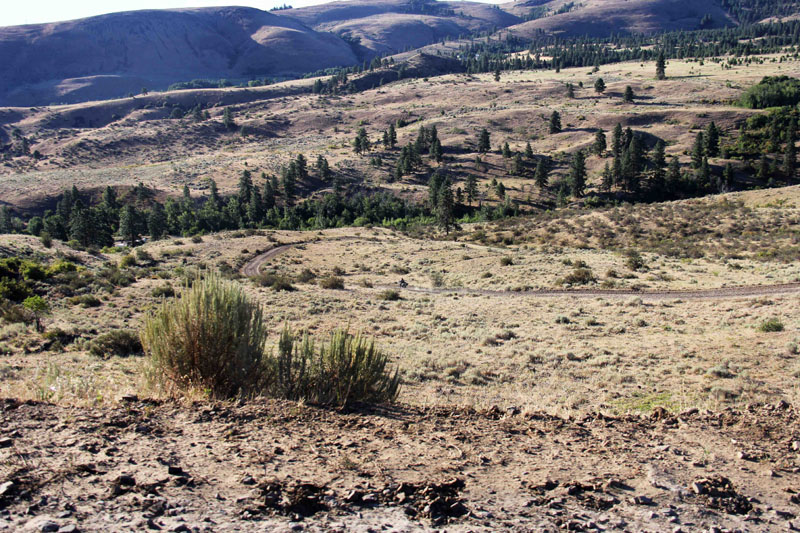 |
Colockum Pass, Washington |
But turning back proved to be a wiser decision than I knew.
(Once again, the rider is far and away, a minute dot in the vastness of the Intermountain West.)
We had to circle all the way back to Wenatchee to be able to cross the Columbia River, and programmed Doofus and Dingus to lead us there-glad at least to be following a different road, instead of turning back. Retreating down the same road feels more like defeat. We began to see wisps of smoke ahead-nothing too severe, maybe like small grassfires that had been deliberately set to fertilize the earth. But then I was seeing scattered patches of flaming brown grass right beside our road, the dry flicker almost invisible in the bright sunlight, but the rippling heat-haze and smoke unmistakable. In just another mile, we rode through a scene of blackened desolation, a charred wasteland, and obviously recent. Both sides of the road were completely black with burned vegetation, smoke still wafting here and there. Half-burned utility poles lay across the road, still smoldering, while the wires lay along the shoulder. (Fortunately not across the pavement, or we wouldn't have dared to cross them.)
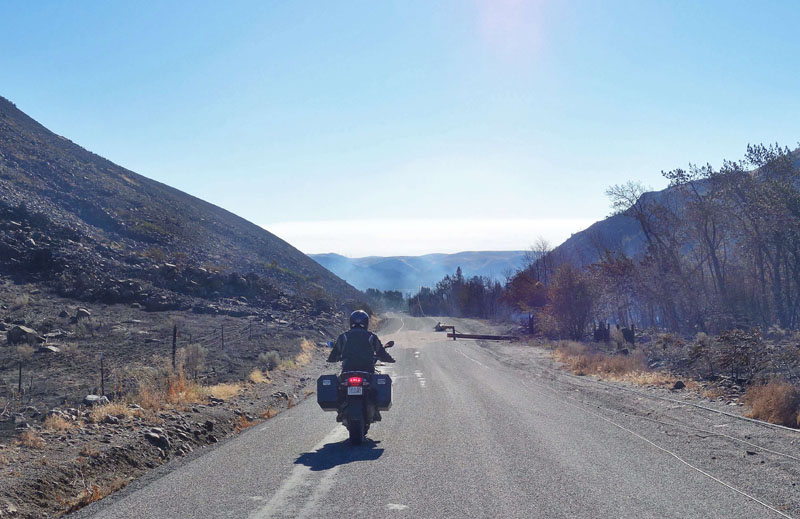
Where transformers had exploded in the heat, the toxic fluids were being absorbed by scatterings of a kitty-litter-like substance-another riding hazard. We passed a couple of destroyed buildings-a mobile home burned to its cross-braced chassis, and a wooden structure left in ashes. Drifts of smoke rose everywhere, resembling the geothermic vents we would soon be seeing in Yellowstone National Park. Later we learned that the fire had started right there, only the previous morning, and had now moved on to... where we were heading.
A couple of police SUVs with flashing lights approached, and I pulled to the side. A hefty sheriff with a smoke-yellowed mustache asked me where we were coming from. I explained as best I could, with much pointing in different directions.
He got all gruff with me. "You head straight down this road, but very slowly, watching for utility and firefighter vehicles. And you find somewhere else to ride."
We started passing firefighting personnel carriers from all over Washington State, even Seattle and little Vashon Island, and the firefighters in their yellow "work clothes." Amid the devastation, a couple of houses had been saved-oases of green lawns around them. One detachment was guarding a roadblock to stop all traffic from entering the area-the very region through which we had just blithely ridden.
Below is the scene of the real fire, as seen from across the Columbia River-very near a remote amphitheater called The Gorge that we had played a few times. (Last show on our Time Machine tour, for one, on July 4, 2011.)
Good thing we weren't booked there that night, because that show would have been canceled for sure. Apart from the venue being downwind of the massive fire, with the sky filling with dense smoke, the deep, rugged river gorge was also clouded with thick roiling banks of white smoke. To the right in this photograph are the blackened sides of the Columbia Gorge, exactly where we emerged, and clearly burned over the previous day (the fire had first been reported that morning) in the inferno's inexorable passage. The so-called Colockum Tarps fire became big news in subsequent days, eventually destroying over 80,000 acres. As we circled around to the south on the interstate, the visibility was reduced to riding through a thick fog.
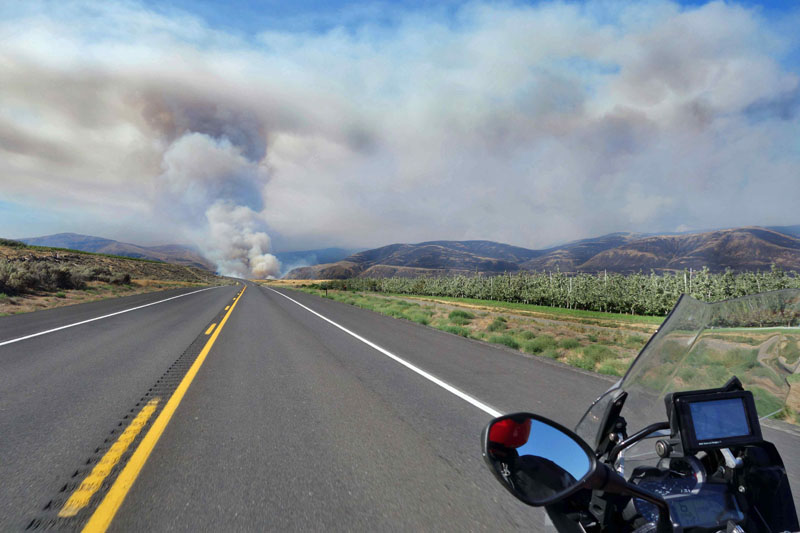
And talk about "not over when it's over," think about forest fires, their effects often calamitous and enduring.
And what about floods? Which brings this story right back to the beginning. (Love it when that happens.) The first show of this final run had been scheduled for July 24 in Calgary, but just a few weeks earlier that city endured a massive flood. The arena we were supposed to play in was underwater up to the tenth row.
It was fairly certain we would not be playing that building, but rather than cancel our show, I suggested to the Guys at Work and manager Ray that we move it somewhere else, to higher ground-maybe outdoors-and play a benefit for those people who had lost so much. Everybody readily agreed, and Ray set about making it happen. It turned out that nowhere in Calgary itself was going to work, and the considered alternatives of Lethbridge, Alberta, and Kelowna, British Columbia, were rejected in favor of... Red Deer, Alberta.
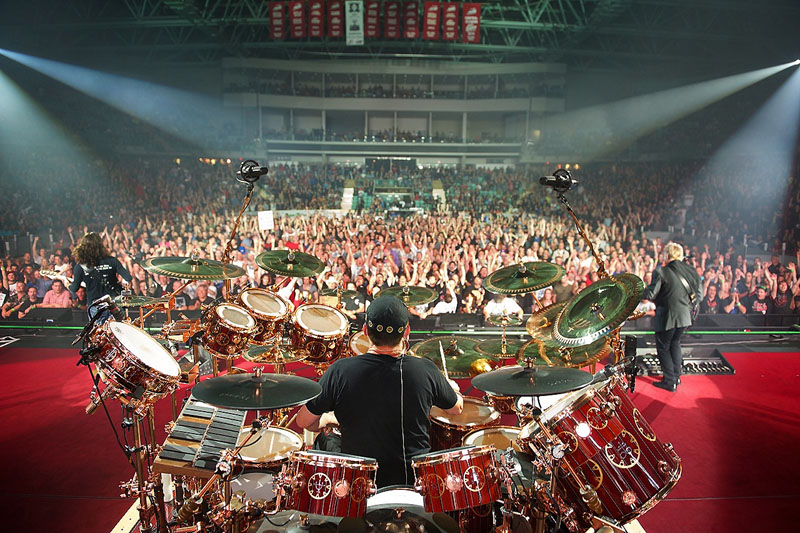 |
Dead Rear, Red Deer |
(I love bringing up place names like these to American readers. I know they're all, like, "What?" Incidentally, to locals, or perhaps typically competitive neighboring towns, Red Deer is "Dead Rear," as Calgary is "Cowfart.")
At least the arena in Red Deer could accommodate our production-the whole superstructure of sound, lighting, and rear-screen technology that surrounds the stage. That is no small concern, or limitation-what usually happens is that the rear screen gets squashed very low behind us. These days some historic stages like Red Rocks in Colorado and the legendary Hollywood Bowl can no longer fit our show. (A touching sign I saw held up in the arena audience in Denver, "I'm Pretending I'm at Red Rocks.") Maybe sometime we'll bring a smaller one. (Doubt it-"Can't stop thinking big" and all that.)
However noble our motives, even what should have been our golden karma could not prevent that show from throwing up a unique challenge just before showtime. In "On Days Like These" I wrote about leaving the stage mid-show in Quebec City because of a looming storm, and how in thirty-nine years we had never once stopped a show like that. Well, this would be the first time in thirty-nine years we ever played without monitors!
Just before showtime we were informed that the monitor board was down, and being worked on feverishly. There would certainly be a delay in starting the show. The possibility of having to cancel this show, out of any of them-a benefit for many worthy causes that would eventually raise over half a million dollars to help them-seemed a particularly cruel twist of fate. I tried to think how we might possibly work around it. Half-joking, I said, "Oh never mind-we'll just play to the house mix."
A little later, Geddy said, "It looks like you might get your wish."
Not exactly my wish!
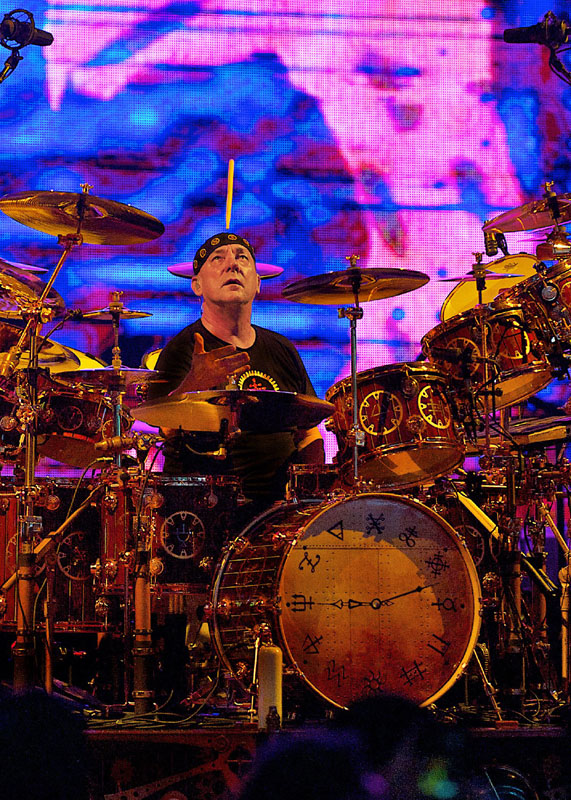
Yikes!
Talk about a juggling act! To explain what that actually meant, each of our pairs of in-ear monitors receives a unique mix of "information." For myself, I have an ever-changing blend that always includes drums and vocals, and usually bass and guitar, but sometimes eliminates those so I can concentrate on a sequence of keyboard patterns or vocal effects that I need to play in sync with-and set up the tempo for in advance, perhaps the biggest challenge of all.
Changes like that might be programmed not just for every song, but maybe a dozen different sections of each song. I had a lot to hold together-especially when the strings were onstage with us. I had to lay down a foundation for nine other musicians.
The other guys might need to hear more high-hat in a particular passage, or more bass drum, or vocals-not to mention countless hours spent refining the perfect balance and stereo placement of each of Alex's 4,000 effects. In the "house mix," these elements are all blended, with lead vocals and guitars to the fore. The things I need to be in sync with are just background textures, barely audible.
But...we did it! For the first set, anyway, because the audio crew was able to get the mixing board fixed in time for the second set. (Much relief there, on my part-and others' too, I'm sure.) But that first set was quite an "adventure" all right, more an exercise in imagination-trying to aurally picture what I was supposed to be hearing. As I said to the Guys at Work during intermission, "My poor brain! I think we got through it okay-but I wouldn't want to hear a recording of it!"
And once again I have let musical adventures distract us from our motorcycle travels. They sure weren't any less dramatic.
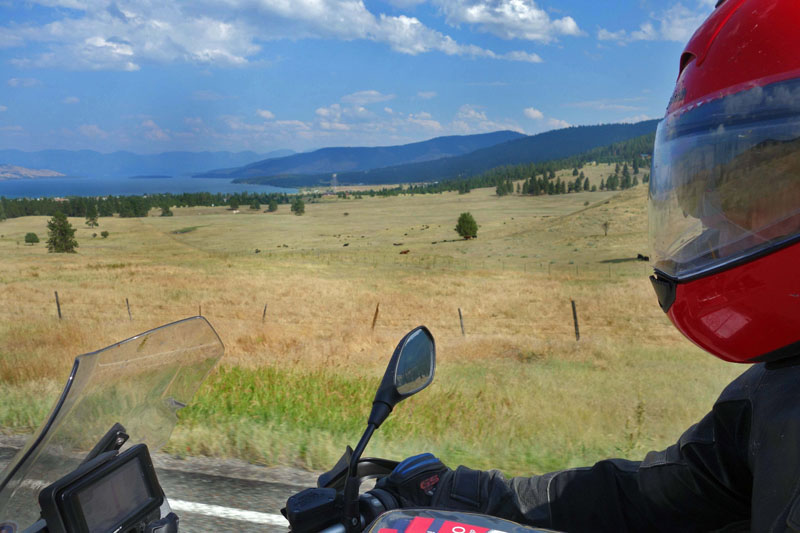 |
Flathead Lake, Montana |
In the early weeks of 2013, I first received Ray's plan for the upcoming shows. I am not too concerned about the show dates-where I play doesn't matter, as long as I play well. I look at the days off, the potential for two-wheeled adventures between those cities. Right away I saw a rare two days off in a row, and in the West!-between Portland and Salt Lake City. Ooh, that would set me up for any number of possible landscapes in the Intermountain West. Picturing the area in my head, my mental map, I fixed on two touchstones-Glacier National Park in Montana, and Yellowstone National Park in Wyoming.
A little preliminary figuring showed that hitting those destinations over two days ought to be "possible"-but that would depend on how you define "possible." It began with a five-hour bus ride from Portland to La Grande, Oregon. After sleeping in the Château Walmart, we unloaded the bikes (with guest rider Chris Stankee from Sabian on my backup bike, Geezer VI), and set off painfully early to ride 523 miles. That would be a long day on any road, but not one of those miles was interstate. It was all challenging two-lanes, mostly through mountainous terrain, with lots of technically-demanding riding.
Crossing the ranching and haymaking country in Idaho and Montana, I observed the people living that life, and considered the similarities and contrasts between them and their southern counterparts in Texas. On both sides of that divide, everything was "big"-country, sky, hats, boots, belt-buckles, and pickups-but there were differences. A double portrait would be worth researching, but one generality is that the Northern "costumes" were less fancy, especially for townspeople-fewer of the kind of Westernized city-folk that Texans themselves refer to as "all hat and no cattle."
And, for the past twenty years I have noticed that little "espresso huts" are common all around the Northwest (not just Seattle-but all the way east to rural Idaho and Montana), with pickups lined up for their morning "jolt." You don't see that in Texas.
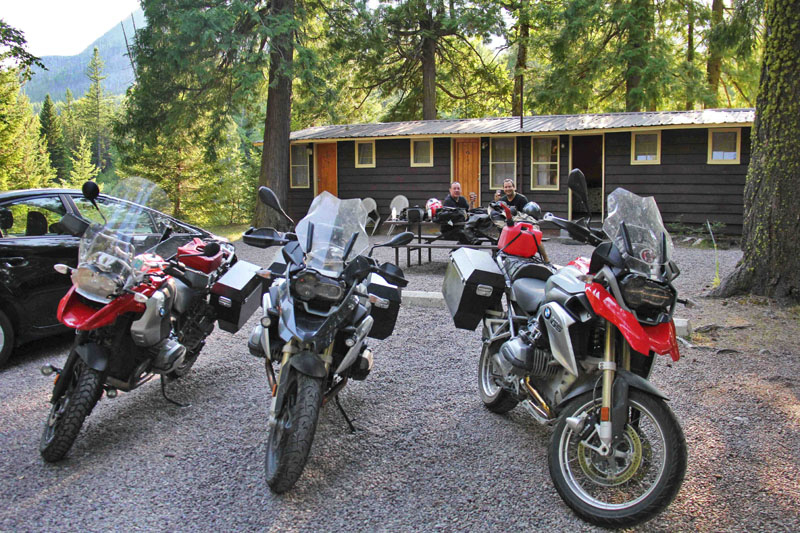
All around us that day, I noticed the usually pin-sharp, super-high-resolution landscapes were hazy, from the smoke spreading downwind from that Washington fire we had "experienced."
It was a punishing day, but a necessary price for a worthwhile goal. That evening found our three motorcycles parked in front of a delightful row of cabins along a blue-green river, on the western side of Glacier National Park. (Earlier in the tour, knowing of my plans to hit more national parks, Michael had bought us each Annual Passes-how proud I was to stop at the gate and display that, to be the kind of person who has an annual pass to America's national parks.)
Those cabins had been booked about three months in advance. Usually I like to ramble around for the day, and just pick someplace to settle down when it gets to be near cocktail time. However, that carefree approach would not be possible in midsummer, in some of the most popular national parks in the country. Every motel and campground we passed in those parts was marked "Full."
I do believe in magic, but know that often it requires some planning.
Years ago I tried to ride through Colorado's Rocky Mountain National Park with Brian Catterson on a midsummer afternoon, and it was a big...no.
Like being in a freeway traffic jam, with nicer scenery.
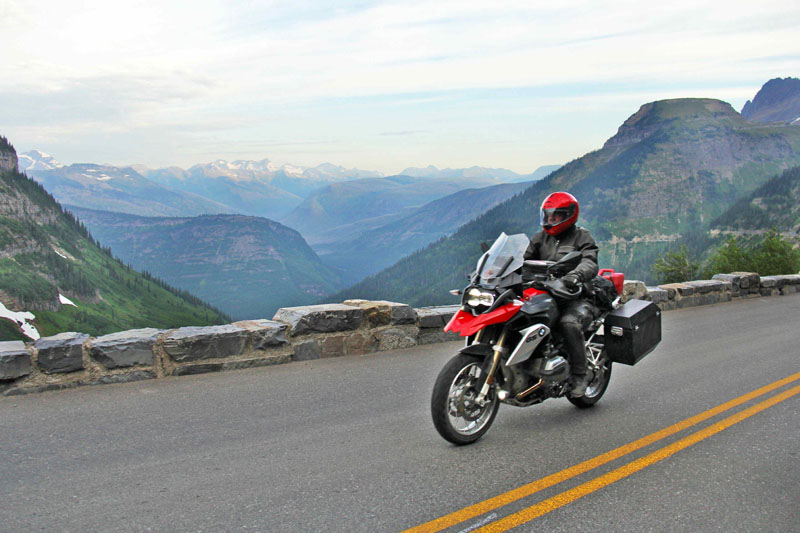 |
Glacier National Park, Montana |
My plan was to stage us just outside the parks, then ride through them at six a.m., before the freight trains of RVs and plodding "processions" of motorcycle cruisers could clog the roads. Glad to say, it was a sound plan, and we were able to experience the magic of those parks with all the space and time the season could allow.
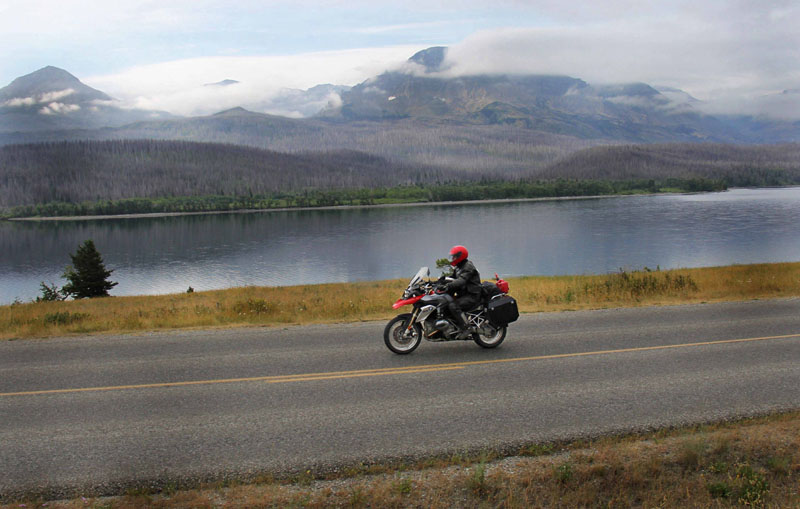 |
Glacier National Park, Montana |
If magic can be prepared for, so too can its opposite-at least to some degree. The red containers of gasoline on the back of my and Chris's bikes came in handy that day, in the wide-open country of Montana. We crossed Glacier on the famous Going-to-the-Sun Highway, one of a very few roads in all North America (and the world) that were built just to carry people to scenery. The Columbia Gorge Parkway in Oregon, Pikes Peak and Mount Evans in Colorado, the Blue Ridge Parkway in the Appalachians, the Natchez Trace in the Mid-South, and the Mount Washington Auto Road in New Hampshire are a few other examples. Nearly all roads follow a simple formula I came up with years ago, wondering about a remote road in Idaho that ended at a mountaintop. In that case, there had once been a mine at that summit, and it suggested a relation that proves generally true, "Every road has money at one end, and a bank at the other." (Come to think of it, most of those "scenic" roads have tolls-so there's still money at one end and a bank at the other.) Road numbers in rural parts of Texas are prefaced with "FM," for "Farm to Market"-a plain example of that principle.
(Ah-but which is the "bank," the farm or the market?)
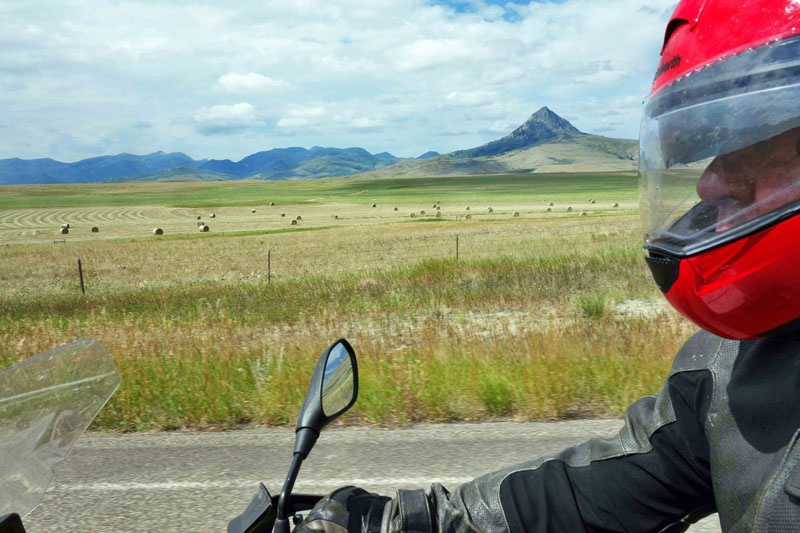 |
Montana Hayfields |
From Glacier down to Yellowstone was another long, two-lane day-440 miles, much of it across a prairie landscape, and even a decent stretch of gravel. The Canadian side of Glacier National Park, in Alberta, is called Waterton Lakes National Park (together forming an "International Peace Park"). Waterton's slogan is, "Where the Mountains Meet the Prairie," and the same was true heading south through Montana to Wyoming. Rugged gray mountains on one side, brown-grass prairie on the other-the skies, alas, still hazy from "our" forest fire. They were blue above, but white and fuzzy around the horizon.
At a gas stop, Michael was excited to tell us how he had seen bears crossing the road, a mother with two cubs, and in the park we had all seen moose, bighorn sheep, and deer. Always nice to see big animals, but that day, the wildest part was going to be the weather.
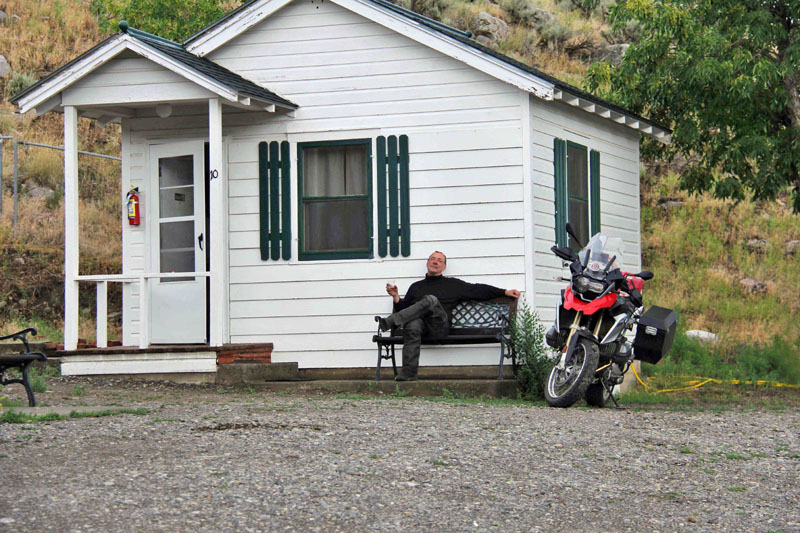 |
1,000 Hard Miles in Two Days... |
Late in the day, as we neared our destination of Gardiner, Montana, dark mountains rose up to blockade the southern horizon, and looming above the peaks were even darker curtains of rain. For the last hour or so, we would surrender to a slower "rain pace" down the valley to Gardiner, just on the edge of Yellowstone National Park. Like the previous night, it was a carefully planned destination, and proved to be a great one-a tour favorite. Our cozy little cabins were a short walk from the small town's selection of restaurants, which is a rare and much-appreciated treat in such mountain towns, like Gunnison, Colorado (which we would also revisit in days to come), Littleton, New Hampshire, or Logan, Utah.
The following day would be the longest distance I think I have ever tried to cover on a show-day-440 miles. Thinking of the adage, "He travels fastest who travels alone," I suggested to Michael that I head out on my own, early, with him and Chris behind me in case of any trouble. They could linger over the tourist attractions, like Old Faithful, that I had seen before, but would cost me too much time on this journey. I told them, "You've probably known about Old Faithful since you were about eight-and when will you get another chance?"
And anyway-I enjoy riding alone (though the end of the ride is more fun with others). Maybe by that point in the tour, I pined just to be alone for a while.
But Michael wasn't having that, especially on a show day. We agreed to get up at six and start riding, and see about breakfast later. However, when I met Chris in the twilit parking area, Michael had already set out, riding straight for Salt Lake City. That didn't make sense to me, but I presumed he had his "reasons."
In any case, I soon forgot about that, because as soon as I started rolling, the tire-pressure warning light flashed yellow, then red, showing that my rear tire was dangerously low. "Not again!," I thought, after going through the same thing in Nova Scotia a few weeks ago. Punctured tires just aren't that common these days. I waved to Chris and pointed to the gas station across the street, where we filled the tire and our tanks. Many times in the past I had been able to limp through a day with a slow leak, sometimes-like in Mexico-having to carry on like that for a couple of days until I could get the tire replaced. (Screws, for example, hold pretty well-big nails, not so much.) Plugging is possible, and I carried the kit for it, but it's sometimes troublesome, and not always effective. I would save that option, if it became unavoidable.
I kept to the intended route, riding south through Yellowstone's dense pinewoods, on a chilly morning (just above freezing) and often foggy. The pace was slow anyway, as we always had to be ready for unexpected obstacles on the road-like large animals. Unlike my previous visit (see "A Little Yellow Cabin on Yellowstone Lake" in Far and Away), we did not see any bison, but occasionally I could smell their funky pungence. (Think "sweaty horse" times ten.) We arrived at Old Faithful (not that "faithful" these days-an eruption can only be predicted by the time and intensity of the previous one), too early for the Visitor Center to be open, so no passport stamp-I had to get one at the ranger station on the way out of the park.
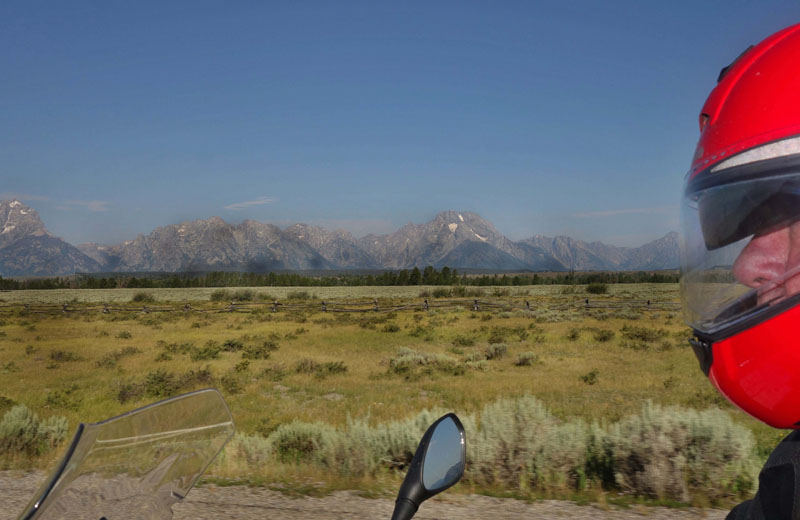 |
Grand Tetons |
We carried on south past Grand Teton National Park, my rear tire still holding its air pretty well. In Jackson, Wyoming-one of those gold-plated Western towns like Sun Valley, Idaho, or Aspen, Colorado, where the streets are lined with Swarovski crystals-I filled up with air one more time.
We had made it almost 300 miles when the road started to descend, and the temperature rose into the nineties. The heat seemed to accelerate the leak, and in the vast, treeless Great Basin country of sage and juniper shrubs, with just a solitary cow here and there (the kind of rangeland that needs an average of forty acres to feed one cow), gas stations were long distances apart. The day's tension kept mounting, and I hoped the tire wasn't about to fail utterly-where I would have to commandeer Geezer VI from Chris, and leave him in the scorched sage to await a flatbed. The GPS listings showed a Sinclair gas station in nearby Randolph, Utah, and we headed for it. This was it-we would have to try to plug the tire, and hope to carry on.
At least the big shiny nail wasn't hard to find, embedded in the black treads. Unlike the thin one I had saved from Nova Scotia, this Montana specimen was a monster-about four inches long, and an eighth thick. When I grasped its crushed head with the Leatherman pliers and pulled it out, the remaining air escaped in one quick sigh. It was a big hole. Chris and I wrestled the plug in, but when we put a quarter in the air compressor (really?), it wouldn't hold air.
Chris said, "You want to try another plug?"
I shook my head, "No-I'm afraid we're done." I had faced this situation before, and knew two plugs were not going to help.
Chris, "a good man in a storm," understood what had to happen. While I shifted my belongings to Geezer VI, he was on the phone to Michael, who was already waiting for us at the BMW dealer in Salt Lake City. They would send out a truck and trailer to pick up Geezer VII-and Chris. I gave him a hug and said, "I'm sorry."
He said, "Hey-we know about 'nails in the road.'"
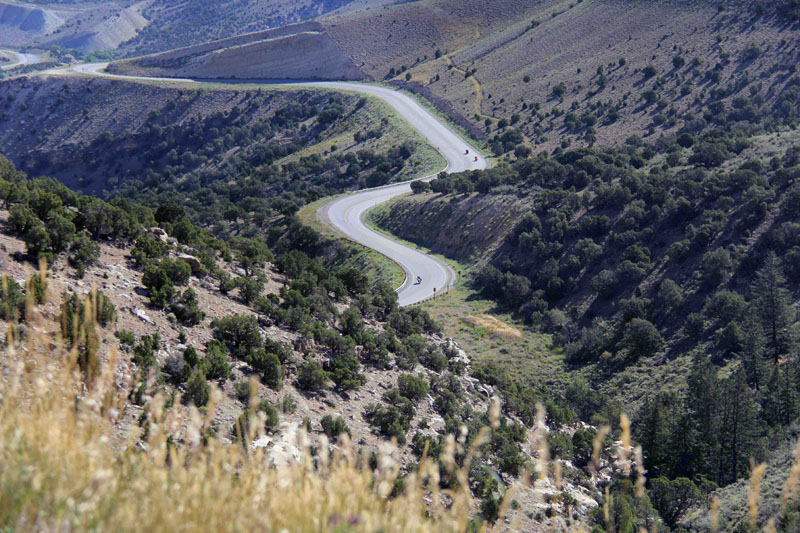 |
Flaming Gorge, Wyoming |
Well said! Yes we did, literally and metaphorically.
Leaving Gardiner to ride through Yellowstone that morning, I was hoping to stop for breakfast somewhere later. As things progressed, so to speak, it was almost ten hours later before I sat in the front lounge of the bus, still in most of my riding gear, and devoured a delicious omelette, courtesy of band chef, Frenchie.
For a show day, it had truly been "the longest day." As for Chris, after his long day, with plenty of waiting around, he arrived with my repaired bike around show-time, then flew home that night. The Salt Lake City BMW dealer came through big-time, working late to replace my rear tire-which was a good thing, because we would have another guest rider for the next couple of days, John Wesley-"Wes"-guitarist and vocalist with Porcupine Tree, and on his own solo work.
Truth to tell, I was really about ready for a rest from riding-from everything-but there was only one more "big" ride, and I couldn't imagine missing it. With a day off between Salt Lake City and Denver, and those landscapes and roads-the most excellent thing I could do that day was not sleep on the bus and hang out in a hotel room.
From a truck stop in Green River, Wyoming (what-no Château Walmart?), Wes, Michael, and I set off south through the Flaming Gorge country-named for the late-afternoon sun reddening the cliffs, by another John Wesley, Powell, a one-armed Civil War veteran who explored much of the Southwest. Powell and his party were good place-namers, too. Making the first known descent of the Colorado River in 1869, through the Grand Canyon, they named one waterway Dirty Devil Creek, after a companion with dubious hygiene. Farther along, to atone for their possible blasphemy, they called another creek the Bright Angel. (Still the name of a lodge on the South Rim.)
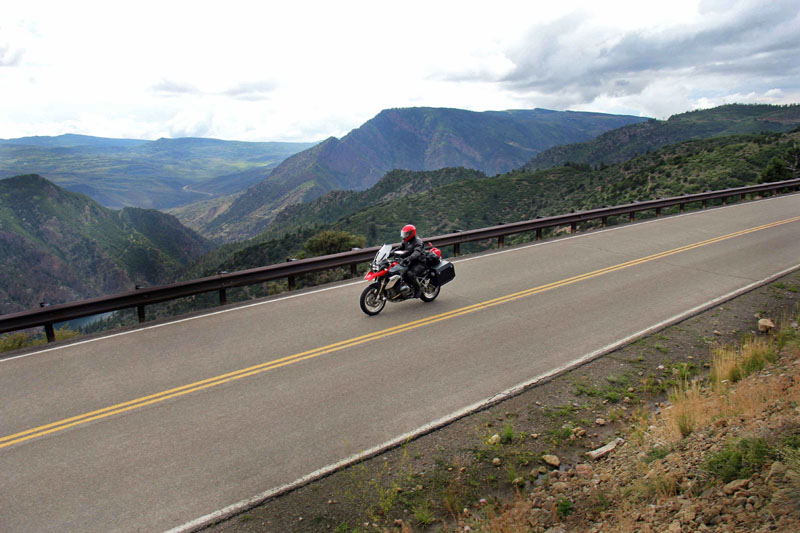 |
Colorado 92 |
Down through a corner of Utah, we crossed into Colorado, occasionally slowed by rain and wet pavement. Late in the day we found ourselves on a truly wonderful road, Colorado 92, high, winding, and lightly traveled, traversing the interior flank of Black Canyon of the Gunnison National Park.
Later, we dodged or endured occasional rain showers down and around to the town of Gunnison. From a stay there with Brian Catterson five years previously, I remembered a charming motel, the Swiss Inn. That day Michael had tried to call it a few times, but the phone just rang. When we got there, the business was obviously shut down. Tell-tale weeds were creeping up through the asphalt (a sure sign of neglect), so it hadn't been open all that summer, at least. Yet after we settled across the highway at the Western Motel, we looked over at the tall sign reading Swiss Inn. It was still lighted, even to the bright red neon of the "No Vacancy" sign below, and small white lights outside each door welcomed...nobody.
I could only guess it had been a sudden and unresolved closing-like if the owner had died (the previous time a gray-haired old lady checked us in), and no one had got around to shutting things down yet.
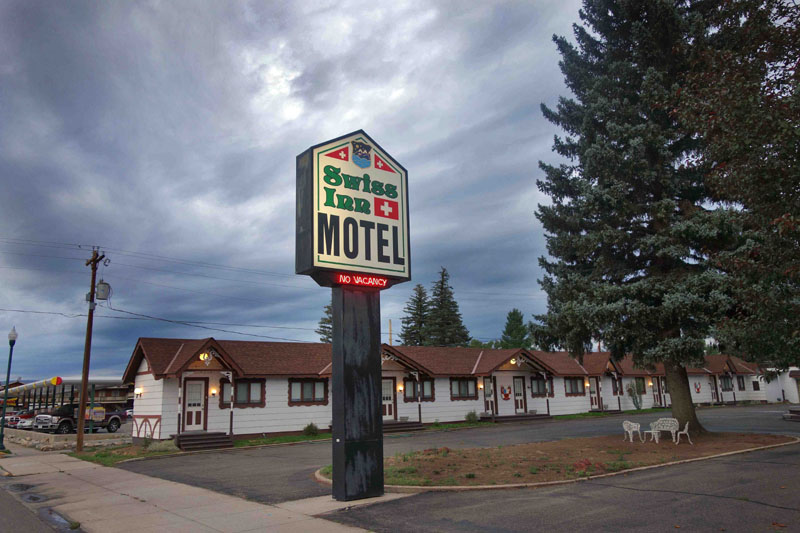
It was the second time this tour we had observed that...motel entropy. (Title!) Whenever I am riding from the Eastern U.S. toward Toronto, I like to stop for the night in Cape Vincent, New York, on the south bank of the St. Lawrence River. In the morning, we take a little ferry across to Wolfe Island, Ontario (with the world's smallest border-crossing facility), around it to a larger ferry over to Kingston, then ride on into work. Over several years, I stayed twice at the Buccaneer Inn, a small motel in Cape Vincent run by an elderly couple-but the second time I noticed the man had suffered a stroke. He was doddering around and trying to be helpful, while his wife followed, taking care of everything-letting him pretend to help. Sadder yet was the next visit, seeing the place dark and empty.
Clearly the Swiss Inn had been somebody's dream-conceived and nurtured with love. But maybe it's not over-maybe the "right person" will come along and keep that dream alive a little longer. Anything can happen. (I was tempted to put in an offer myself-and make Michael stay there and run it...)
The next early morning (quite a series now) carried us over Monarch Pass, at 11,312 feet-where Brian Catterson and I had experienced a blizzard, almost exactly five years before (in July!), riding from the Swiss Inn to Denver. Following the same route, Michael, Wes, and I descended into the grassy basin known as South Park, and, as Brian and I had done, stopped for breakfast at a rustic café in Fairplay-one of the "models" for the enduringly brilliant animated series, "South Park." (Perfect coincidence that my bandmates had dined with Matt Stone and his wife in Boulder the previous night.)
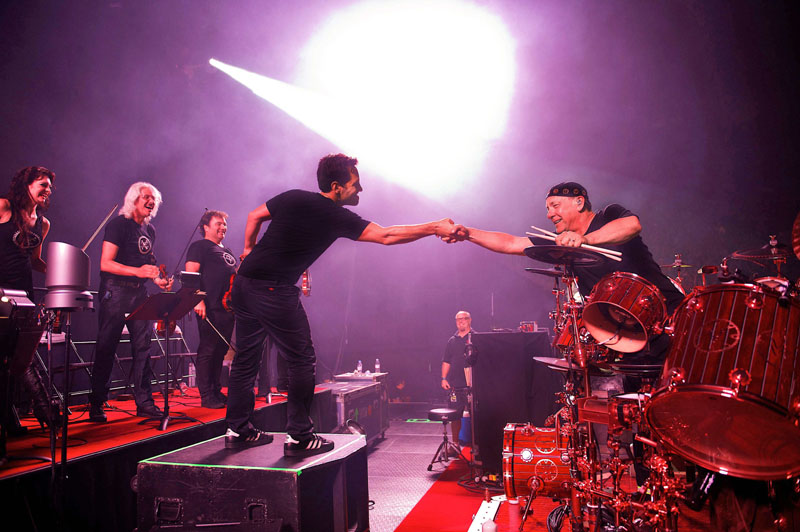 |
Il Maestro, Paul Rudd |
Then a short, easy run to the arena in Denver, where I started my show-day duties by changing the oil in both my motorcycles. My older Canadian bike, Geezer VI, would be going on the trailer for the last time, and eventually to my home in Quebec for winter storage-with clean oil. My American bike, Geezer VII, would be trucked back to California after the last show-and after one final easy ride across the backroads of Kansas. Nothing too daring or demanding, a simple valedictory speech-a parade lap.
A victory lap.
Which brings us back to the beginning-er, the end.
The final show in Kansas City.
See how I did that?
Because this way, it's over.
But it's never over...